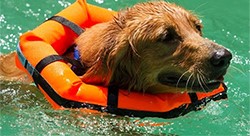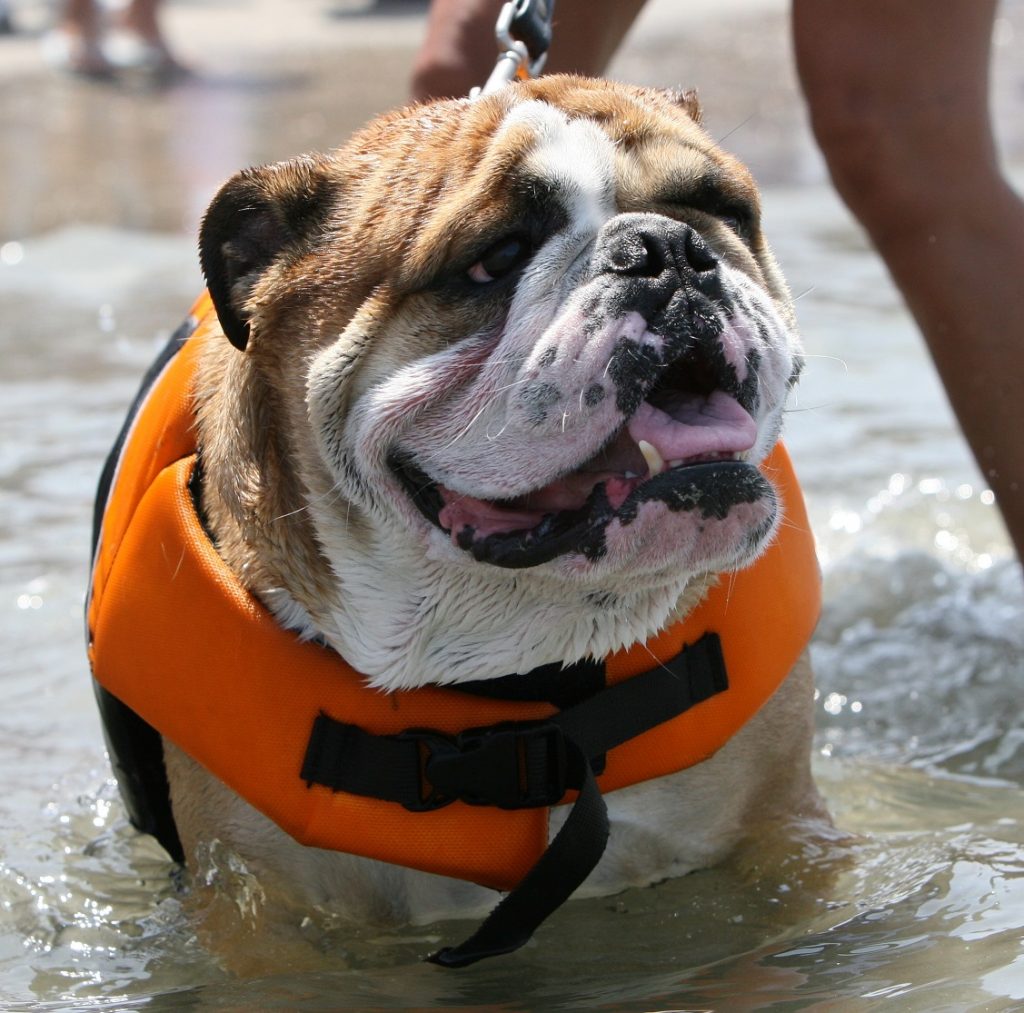Just because your dog’s last name is “Retriever” doesn’t mean he knows how to swim! You can however, help him beat the heat during those dog days of summer with swimming lessons. That’s right! Kids take swimming lessons and now your dog can too.
An estimated 10,000 dogs drown each year in the United States mostly because they easily found their way into a pool, but couldn’t find their way out. Once in the water animals tire while splashing about, so it is crucial they learn how to get out of the water and stay afloat. Even with a life jacket on, if your dog is not supervised his head can remain in the water, so find a properly fitting water collar that helps keep his head above water! Personally, I’m a fan of the HedzUp Water Collar, and as a student of mine, mention Promo Code: CRUSADER for a 15% discount!

Many places around the country teach dogs to swim, but there are benefits besides safety. “It’s a blast swimming with my Springer Spaniel Jake,” exclaims 12-year-old Lisa K. of Oviedo, Florida, “even when he beats me across the pool.”
According to Kelly Armstrong of Clever Paws Dog Training who teaches dogs to swim at Camp Gone to the Dogs in Marlboro, Vermont, “Swimming allows dogs to burn off excess energy. It is such great exercise that a lot of my clients with performance dogs (those that compete in agility, flyball, herding, frisbee, tracking and obedience) use swimming to keep their dogs in top physical condition because the better conditioned a dog is, the less likely he is to injure himself.”
Swimming can be a safe aerobic exercise for the pooch with a paunch since the water takes pressure off the joints while allowing him to burn calories. Swimming is also terrific therapy for dogs recovering from surgery or that have arthritis. Whether the body of water is an ocean, lake or pool, the health benefits are great for both you and your dog.
Lessons can build confidence in your dog in a safe environment, but don’t all dogs just know how to swim? Actually, some won’t even get their paws wet while many just aren’t built for water sports. The short-necked, large-chested breeds like Bulldogs often have trouble keeping their heads above water, but sometimes even Retrievers and Spaniels may not initially seem at home in the water and may need practice to perfect their “doggie paddle.”
How do you determine if your dog is a natural born swimmer or not? One telltale sign can be when your pooch uses only his front legs and tries to bring his paws clear out of the water, slapping at it. With a little help from you supporting him under the belly, your dog can begin to also use his hind legs and tail while he paddles.
A few simple rules can make for a lifetime of fun:
- Practice Safety First
Never leave your dog unsupervised around the water. Install a pool fence or safety alarm. Make sure he knows where the steps or ramp are located. Place a large vertical marker that moves (such as a plant or a flag) by the steps so your dog can easily orient himself. Show him the steps and say ‘steps.’ Then place him gently in the water (NEVER throw him in) with his feet on the top step and let him gain his footing. Take him a short distance away and let him swim to the steps, very gradually increasing the distance. Stay in the shallow end, and keep the lessons short – no more than ten minutes. Always maintain control of your dog by using a leash or long line attached to a doggie life jacket or harness.
If you swim in lakes or other natural bodies of water, vaccinate your dog against Giardia which can cause vomiting and diarrhea and can be passed along to you! Avoid water with a strong current, and stay away from boating and fishing areas where your furry friend’s paw may discover a hook or worse. Also watch out for stumps hidden in the water that your dog could dive onto.
Avoid swimming in water over your own head. A panicked pooch may try to “climb aboard” and push you under.
Dogs too can get sunburned, especially around the nose and ears, so talk to your veterinarian about sunscreen and make sure you get your dog to the shade often.
As for meals, since food stays in our dog’s tummies longer than in ours, never do any type of exercise for 1 1/2-2 hours after meal time. This include taking a swim. Not only could he vomit, but the movement on a full stomach could cause life-threatening bloat!
- Ease Him In
Avoid bad experiences. Make sure the water isn’t too cold, and never throw or push your dog into the water. Lure him with a toy or treat on to pool steps or the gradual slope of a lake. Armstrong explains, “Some dogs will wade in as long as they can feel the bottom.”
My Chikita (Chow-Akita) Haiku prefers just to sail around the pool in his boat! Pay attention and go your dog’s speed. Just like us, they learn by example, but also just like us…if they have a bad first experience, it’s so much harder to attempt a second!
- Take a Break
Some eager-to-please dogs won’t stop. If your dog starts breathing heavily or if his back end begins to sag in the water, get out and take a rest.
- Rinse Off
Chlorine can irritate skin and eyes while bacteria from lakes can make your pet sick. After swimming, rinse or shampoo your dog’s coat, and make sure you dry out his ears.
- Have Fun
Although dogs generally want to please us, you’ll know if your dog is truly enjoying the water. Every sport is not for everyone or every dog! Wading in the kiddie pool may be more his speed or he just may be a land-lover at heart, but if your dog is having fun…you will too!
Once he knows how to say afloat and how to get out of the water, there are many other fun activities you can do with your canine buddy: Canoe paddling, dock diving, retrieving contests and even team swims await you and your four-legged Michael Phelps or Amanda Beard.
Dock Jumping uses a dog’s drive to see how far he can jump off a 40 foot dock into a 40 foot pool of water. According to Splash Dogs’ 2007 Jr. Handler of the Year, Annie H., age 11 of Reno, NV, “Most dogs and their handlers are there for the fun, but they also get plenty of exercise.” Annie competes with her 5-year-old Australian Cattle Dog Pepper. Says Annie, “I hope more kids give it a try because it really is a great way to have fun with your dog, learn sportsmanship and make new friends.”
One day at practice, Annie wanted to try a technique that some of the grown-ups use. “I was standing at the edge of the dock holding Pepper by the collar and forgot how much stronger he is than me, so when he decided to jump in right away, we both went into the water. We had a good laugh about it, but I’ve never tried that technique again.” Remember your strengths and your dog’s — like humans, some are natural land lubbers, but whatever you do together to beat the heat, have a great time together!
______________________________________________________________________________
Note: The articles on this page are copyrighted. Please do not reprint or use portions for any purpose without written permission from the author. Request permission for usage by sending an email explaining how you’d like to use the materials and what parts specifically. Thank you in advance!











